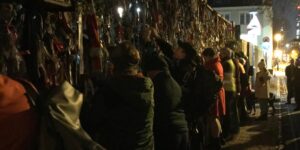

For the last 25 years, a little-known organisation have been meeting in the back streets of Southwark to perform sacred rituals and speak with the dead, illuminated by the glow of The Shard and the light of the moon.
This is not dark magic, these are the monthly evening vigils held by the volunteers at Crossbones Graveyard, a community garden in Southwark, that sits on the site of an ancient cemetery that was used to house the remains of the poor and the downtrodden for hundreds of years, but now acts as a shrine to all outcasts.
“I don’t think there is a vigil like this anywhere in the world and I don’t think there is a garden anywhere that’s solely dedicated to honouring the outcasts,” said Jennifer Cooper, a volunteer at the garden that conducts the vigils. “That’s why we’ve fought for over 25 years to stop it being built on, because it’s special and it’s precious.”
The volunteers gather on the 23rd of each month to remember not just those buried, but also those that have passed away more recently.
This month’s event marks their 25th anniversary and is their 300th vigil, having continued uninterrupted through the pandemic.
The ceremony involves rituals such as tying ribbons of remembrance to the old cemetery gates, candles, poetry readings and the chance for those attending to speak about lost loved ones or share other thoughts and feelings.
“Empathy is how I would describe this place,” Said Dave 500, so called because he was the 500th person to sign a 2008 petition to stop the site being developed and who attends regularly to remember his son, Jason, who passed away in 2011. “I had never come here before then but now I attend as often as I can because it’s helped me a lot.”
The host also, at times, channels the voice of ‘The Goose’, the name given to the spirit that the group’s founder, John Constable, claims to have seen at the site on 23rd of November 1996 and who inspired him to save the site and write a book of poems entitled the Southwark Mysteries that now forms the basis of the vigil’s poetry readings.
The vigils are open to public and this month’s ceremony was attended by everyone from takeaway delivery drivers and circus performers to city workers and families with young children.
In October this year, the Mexican ambassador paid it a visit and gifted the place a statue of La Catrina, who embodies the spirit of the dead.
“This is family,” said Jennifer. “We all talk to each other about our losses and our joys and we’re together in that.”
“Deep down we are all humanity and anything that taps into that is meaningful and I think that’s important.”
For now, Crossbones is protected by a 30-year lease that prevents development on the site, although the landowners, TFL, did built an electricity sub-station on it’s eastern edge in 1996.
That construction unearthed 148 skeletons, less than 10% of the estimated 15,000 people who are buried in Crossbones.
Of these 148 skeletons, only one was found fully intact and became the focus of a 2010 BBC documentary.
There were plans for further construction but these were stopped after pressure from the volunteer group and public outcry, which ultimately resulted in what was then a patch of wasteland being turned into a thriving community garden that is maintained by a diverse network of devoted volunteers.
Crossbones was set up in the 12th century by the Bishop of Winchester to bury the remains of the ‘Winchester Geese’ – the sex workers who were forbidden to ply their trade in the City of London, but were permitted to south of the river, provided they paid a tax to the church via the bishop whose palace was located nearby.
This practice continued in some capacity until 1853, when the graveyard was closed due to being a public health concern and “completely overcharged with dead”.

